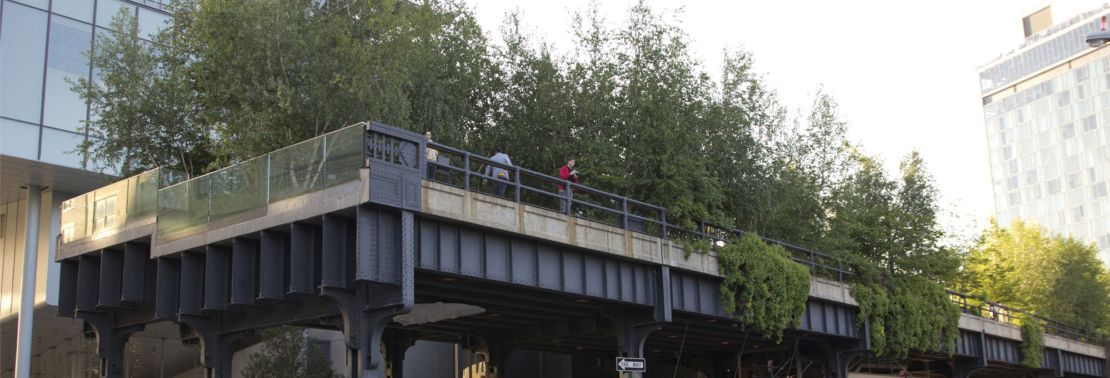A Comparison of the Three Phases of the High Line, New York City: A Landscape Architect and Photographer’s Perspective
“A Comparison of the Three Phases of the High Line, New York City: A Landscape Architect and Photographer’s Perspective” compares Phase One with Phase Two, and describes what is proposed for Phase Three. Design features to be reviewed include the walk system, seat furnishings, plantings, signage and graphics, water feature and drinking fountains, public art, lighting, maintenance and irrigation, and Phase 3. The author also offers suggestions on economic impacts, restrictions and user activities, sustainability, and studies/research.
Originally, due to the length and photo essay nature of the contribution, the series was presented approximately every few weeks in 14 parts between 2013 and 2015; to ensure background information, the Series Introduction is repeated on all.
Part 3 – Plantings
By Steven L. Cantor, Landscape Architect – Originally Posted January 13, 2014
All Photos © Steven L. Cantor unless otherwise noted
Series Introduction
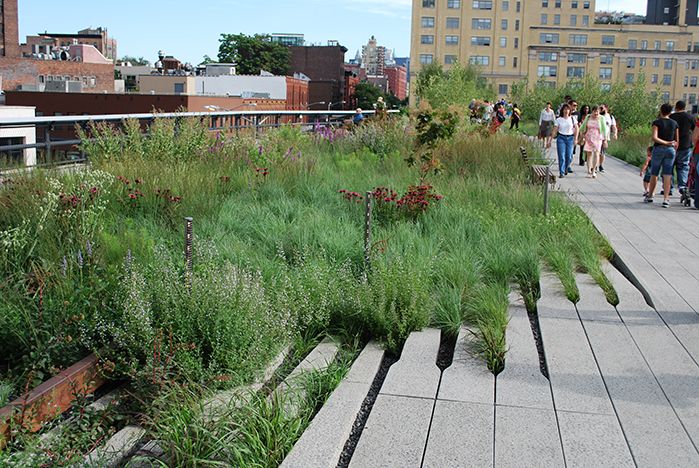
Phase One High Line on July 15, 2009.
Designed by landscape architect James Corner of Field Operations, architect Ricardo Scofidio of Diller Scofidio + Renfro with planting design by Piet Oudolf, the High Line, the remarkable linear park built on an abandoned railroad viaduct in New York City, has been enormously popular.
The design team anticipated how well green roof technology would function and adapt to the viaduct since it could handle at once the huge weight of several fully-loaded trains carrying heavy tonnage. As an intensive green roof, it has very few structural load limits which would curtail use. At peak use times there can be lines of pedestrians waiting to enter with as many as 20,000 visitors per day on weekends.[1]
The High Line has won numerous awards, and in particular several as a green roof, for example, in 2013 and 2010 from the American Society of Landscape Architects, Green Roofs for Healthy Cities in 2011, and in 2010 from the International Green Roof Association. This is a rare public project in which the success of the initial phase contributed to a high level of funding for subsequent phases.
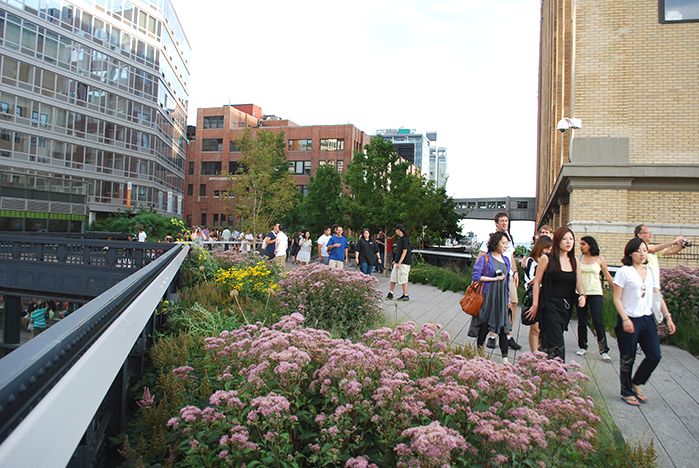
7.16.11.
The High Line has benefited from intense scrutiny as a result of lectures in which the designers were questioned; public hearings, media critiques in newspapers, journals, and blogs; lobbying from specific organizations, such as the Rainforest Coalition; and comments from city government and other public officials.
Improvements or adjustments were implemented to some design elements of the first phase, and significant modifications were done in the second phase. Are these changes aesthetic, appropriate and ethical, and are they consistent with the goals of sustainability? Is the High Line a sustainable design?
Part 3: Plantings Discussion
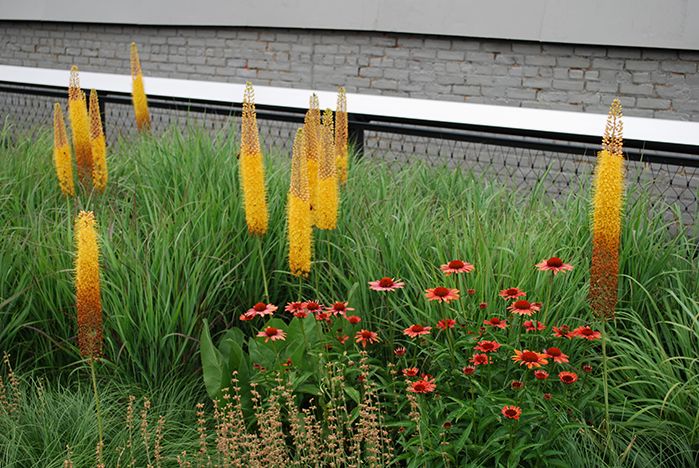
Foxtail lily, Eremurus stenophyllus, with Rudbeckia sp in foreground; 6.12.10.
The most remarkable plantings and combinations of plantings abound on the High Line. The designers have provided a palette of often surprising materials surpassing expectations.
When the High Line was being designed, there was a general indication that the landscape was to be a grassland matrix interspersed with a variety of other plant materials; in short, a simulated prairie. As it has been implemented, one section of the High Line, the Northern Spur, where the tracks entered one of the industrial warehouse buildings of West Chelsea located off the main High Line route (between W. 15th and W. 16th Street, south of the Tenth Avenue Square), was planted in Phase One to simulate this pre-existing landscape as closely as possible.
The current website which is updated to reflect the latest design, once described a prairie landscape, but now indicates that “the High Line’s planting design is inspired by the self-seeded landscape that grew on the out-of-use elevated rail tracks during the 25 years after trains stopped running. The species of perennials, grasses, shrubs and trees were chosen for their hardiness, sustainability, and textural and color variation, with a focus on native species. Many of the species that originally grew on the High Line’s rail bed are incorporated into the park’s landscape.”[4]
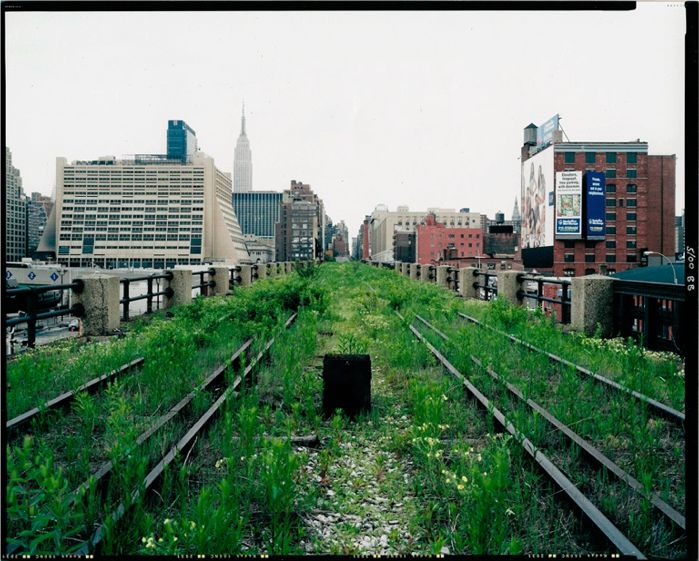
A Railroad Artifact, 30th Street, May 2000; Joel Sternfeld © 2000, courtesy of the High Line.
Photographs by Joel Sternfeld of the landscape that naturally adapted to the thin, gravelly soils on the abandoned railroad trestle were used to promote the idea of developing it as a park.
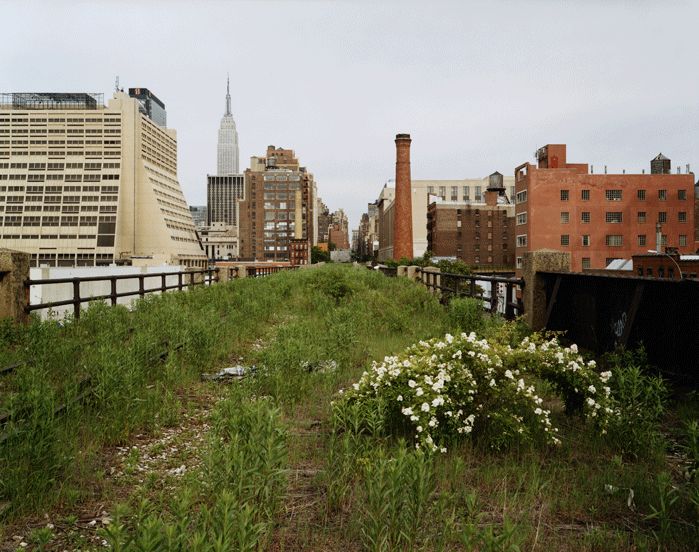
Looking East on 30th Street on a Morning in May, 2000; Joel Sternfeld © 2000, courtesy of the
High Line.
My reaction on almost any walk I’ve taken is delight in seeing unusual grasses, wildflowers, perennials, many of which will be blooming or displaying fascinating foliage or textures, and also appreciation for the accompanying shrubs and trees.
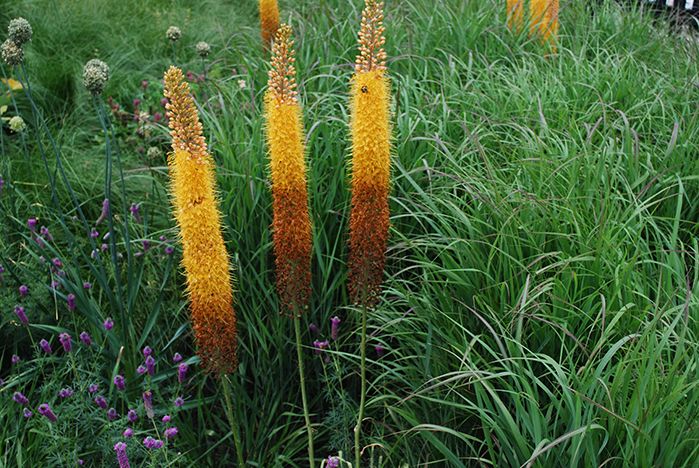
Spectacular displays of perennials, as well as shrubs, grasses and trees create a varying landscape full of wonder; 6.12.10.
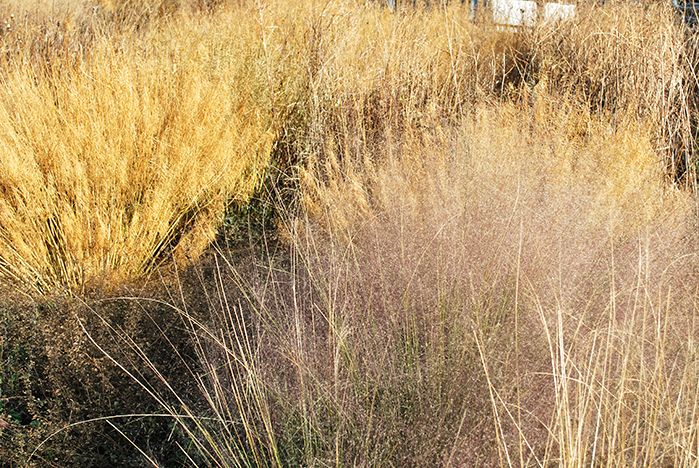
12.01.13.
The occasional introduced non-native plants as accents, such as roses and varieties of hydrangeas and witch hazel, only emphasize what spectacular displays are to be part of the experience of a leisurely walk in this park. It is helpful to observe the Northern Spur landscape to compare to the much more variable horticultural collections of primarily native plants, with many non-native accents, that occur routinely and effectively in most other sections of the High Line.
I particularly admire, for example, how well used are groupings of large shrubs and small trees: several species of magnolias combined in the Philip A. and Lisa Maria Falcone Flyover area with sassafras and redbud; smokebush, birch and amelanchier near the Gansevoort Woodland entry; the grove of three-leafed maples at the Tenth Avenue Square; and scattered oaks amidst some of the grasslands plantings, which resemble the fertile prairies of the Midwest, and so on.
The 23rd Street Lawn and Seating Steps is an attractive raised lawn of about 4,900 SF (455.22 square meters) extending from an area south of West 23rd Street to large bleachers of reclaimed teak which anchor the southern end near West 22nd Street. The lawn is popular for resting, sunbathing and occasional informal games, especially for children. Due to its intensive use, it is periodically closed for aeration and rejuvenation. Irrigation was incorporated late last summer or fall (2013).
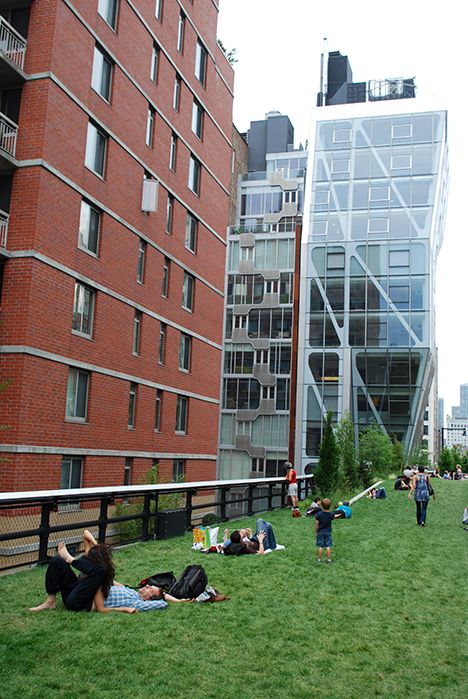
Enjoying the Lawn and Seating Steps; 6.16.11.
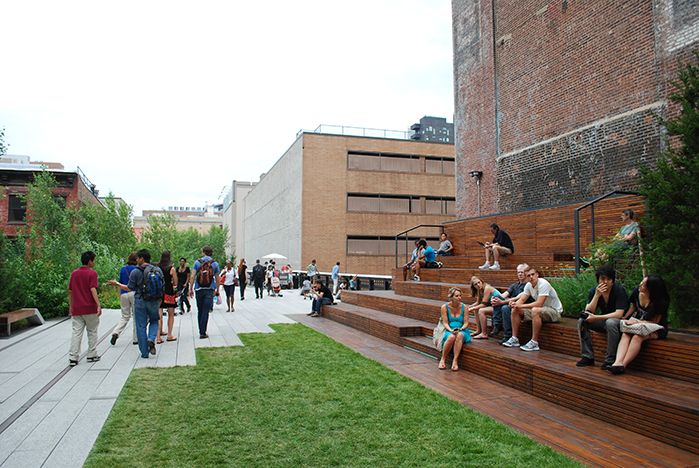
6.16.11.
One can generally see and appreciate the presiding horticultural theme and diversity of plant selections of many of these sections of the High Line: Gansevoort Woodland, Washington Grasslands, Chelsea Grasslands, Chelsea Thicket, Wildflower Field.
The planting design is also remarkable in including a continuous sequence of blooms. Every time that I’ve visited the High Line, at any season, there is always something blooming. This is as masterfully done as any horticultural installation I’ve visited. In this respect, it matches the Brooklyn Botanic Garden, one of my favorite places in New York City, where continuous seasonal interest is a major theme of the diverse plantings.
Additional High Line Plantings Photos
That’s it for now. I hope that these different sections of text and images of the High Line will generate discussion.
Come back next time for Part 4 of “A Comparison of the Three Phases of the High Line, New York City: A Landscape Architect and Photographer’s Perspective” where I’ll discuss Signage and Graphics.
Steven L. Cantor
Photos © Steven L. Cantor are available for individual purchase.
Cumulative 14-part “A Comparison of the Three Phases of the High Line, New York City: A Landscape Architect and Photographer’s Perspective” Series End-notes
1. Ulam, Alex. “Back on Track,” Landscape Architecture Magazine. Volume 99, No. 10, October, 2009, p. 97.
2. http://www.thehighline.org/news/2012/01/24/major-milestone-for-the-high-line-at-the-rail-yards
3. http://www.thehighline.org/sustainability
4. http://www.thehighline.org/design/planting
Publisher’s Note:
See Steven L. Cantor’s ENTIRE 14-part “A Comparison of the Three Phases of the High Line, New York City: A Landscape Architect and Photographer’s Perspective” Series.
Steven L. Cantor, Landscape Architect
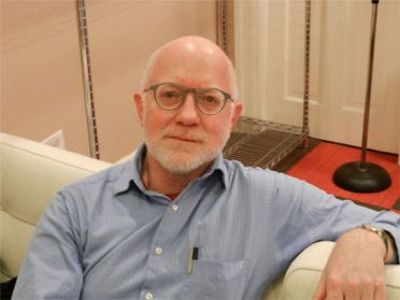
Photo by Thomas Riis.
Steven L. Cantor is a registered Landscape Architect in New York and Georgia with a Master’s degree in Landscape Architecture from the University of Massachusetts, Amherst. He first became interested in landscape architecture while earning a BA at Columbia College (NYC) as a music major. He was a professor at the School of Environmental Design, University of Georgia, Athens, teaching a range of courses in design and construction in both the undergraduate and graduate programs. During a period when he earned a Master’s Degree in Piano in accompanying, he was also a visiting professor at the College of Environmental Design at the University of Colorado, Boulder. He has also taught periodically at the New York Botanical Garden (Bronx) and was a visiting professor at Anhalt University, Bernberg, Germany.
He has worked for over three decades in private practice with firms in Atlanta, GA and New York City, NY, on a diverse range of private development and public works projects throughout the eastern United States: parks, streetscapes, historic preservation applications, residential estates, public housing, industrial parks, environmental impact assessment, parkways, cemeteries, roof gardens, institutions, playgrounds, and many others.
Steven has written widely about landscape architecture practice, including two books that survey projects: Innovative Design Solutions in Landscape Architecture and Contemporary Trends in Landscape Architecture (Van Nostrand Reinhold, John Wiley & Sons, 1997). His book Green Roofs in Sustainable Landscape Design (WW Norton, 2008), provides definitions of the types of green roofs and sustainable design, studies European models, and focuses on detailed case studies of diverse green roof projects throughout North America. In 2010 the green roofs book was one of thirty-five nominees for the 11th annual literature award by the international membership of The Council on Botanical & Horticultural Libraries for its “outstanding contribution to the literature of horticulture or botany.”
Steven’s most recent book is Professional and Practical Considerations for Landscape Design (Oxford University Press, 2020) where he explains the field of landscape architecture, outlining with authority how to turn drawings of designs into creative, purposeful, and striking landscapes and landforms in today’s world.
He has been a regular attendee and contributor at various ASLA, green roofs and other conferences in landscape architecture topics.
In recent years Steven has had more time for music activities, as a solo pianist and accompanist. In 2011 he performed a solo piano program at the Winter Rhythms festival at Urban Stages Theater. He’s a regular performer at musicales hosted in Chelsea and other settings in Manhattan. On August 25, 2013, Leonard Bernstein’s birthday, he performed with Stephen Kennedy Murphy a program of excerpts from the composer’s MASS and Anniversaries.
Steven joined the Greenroofs.com editorial team in December, 2013 as the Landscape Editor. In February, 2015 he completed his 14-part series “A Comparison of the Three Phases of the High Line, New York City: A Landscape Architect and Photographer’s Perspective.”
 Greenroofs.comConnecting the Planet + Living Architecture
Greenroofs.comConnecting the Planet + Living Architecture
